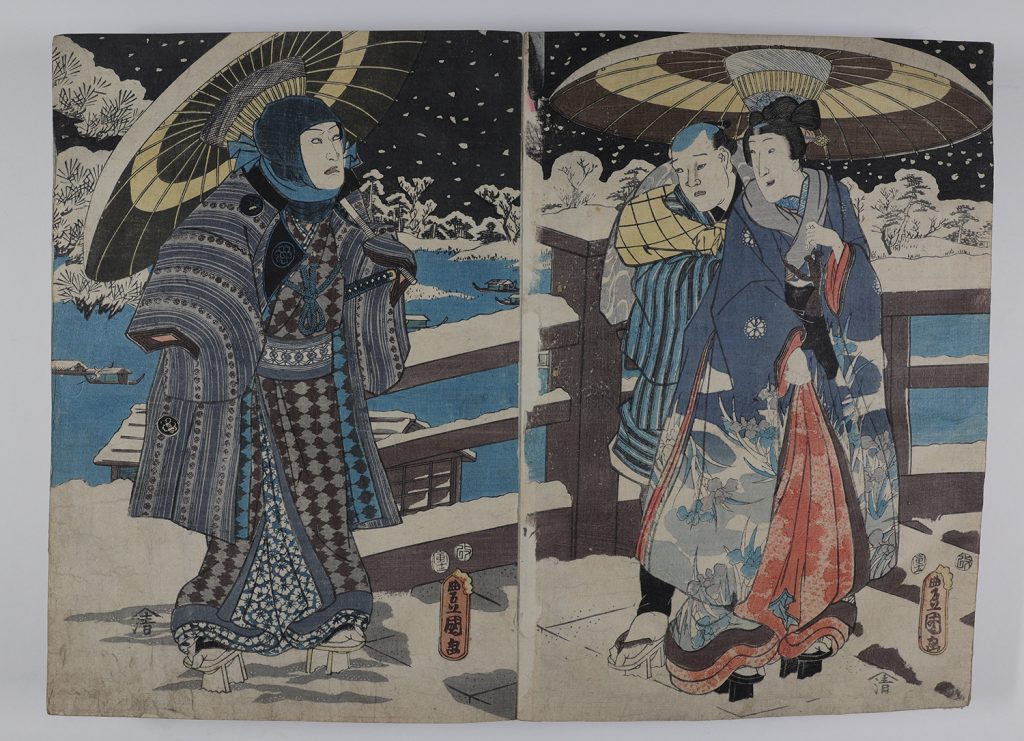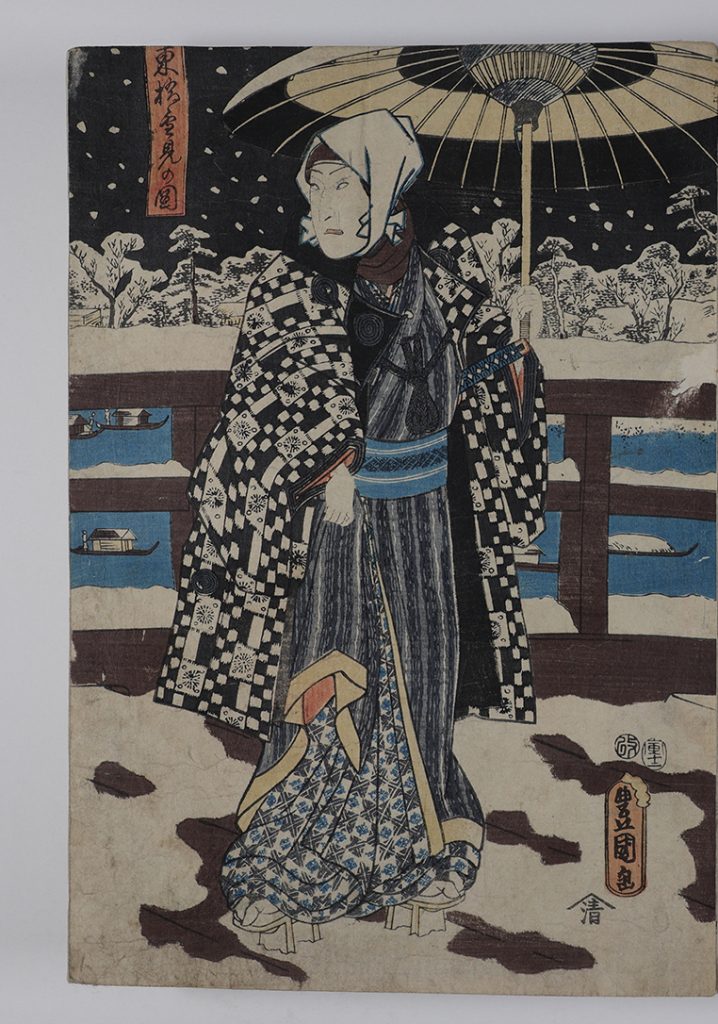Plates 13-15: Image of snow viewing on the East Bridge
Plates 13-15: Image of snow viewing on the East Bridge
Utagawa Kunisada 歌川 国貞 (Toyokuni III) (1786-1865)
Azumabashi yukimi no zu 東橋雪見の図 (Image of snow viewing on the East Bridge) (1854)
Ink and color on paper
Seals:
Publisher: Yamazakiya Seishichi 山崎屋清七
Censor: Aratame 1854-XII, and Aratame seal for approval
Carver:
Artist: Toyokuni ga
In this triptych, four figures are captured in a tableau on a bridge. Snow falls around them, blanketing the ground in white, a stark contrast to the night sky. Behind the bridge, boats rest in the blue water. The right panel of this triptych depicts the actor Ichimura Uzaemon IX 九代目市村羽左衛門 (1724-1785),1 who was active from 1731-1785.2 He is dressed as a samurai with the hilt of a sword peeking out of his robes. In one hand he holds an umbrella to protect himself from the snow and in the other he clutches up part of his robes, allowing for freer movement. His head is turned back towards the figures in the other panels, and arched eyebrows in combination with a down-turned mouth depict a look of irritation. To the left, in the middle panel of the triptych, stands a courtesan with her servant. The servant is holding bags, presumably the courtesan’s belongings, and an umbrella to keep them dry. A look of surprise and concern rests on their faces, while they too turn back to see the man on the left. The left print depicts this man dressed as a samurai holding an umbrella. His face is turned up slightly as he looks with what seems to be anger at the individuals on the bridge. Both Ichimura Uzaemon IX and this man are dressed in thick robes with scarves wrapped around their heads. The courtesan wears multiple layers, and her hair is adorned with a hairpin and a comb.
With the exception of the servant’s robes, each of the subjects clothes depict their family crests, small patterns present on their shoulders and sleeves, specific to each of their families’ lineages. This is how Ichimura Uzaemon IX was identified–the crest indicates his identity. Curiously, the family crests on the courtesan and the man are currently unidentified. A similar crest to the one adorning the courtesan’s robes can be seen in other ukiyo-e prints completed by Utagawa Kunisada, with the difference being in the number of petals on the flower.
The complexity in the subjects’ clothes, the winter background, and the boats reflect the time the prints were created, as highly detailed images had become the norm for Kunisada around the 1830s to the late 1840s.3 The attention to detail partly arose from a general improvement of wood carving within the industry as well as Kunisada’s push for stronger vibrancy of colors.4 Kunisada’s attention to fashion specifically comes out in this print set; he would often depict individuals dressed in the latest trends set within natural scenes such as the snowfall.5 We may infer from the subjects’ seemingly higher statuses and choice of striped and checkered clothing that these patterns were in trend. As seen with the fashion in this work, ukiyo-e prints provide cultural insights on life in the Edo period.
Mollie Lombard
Major undeclared (as of Spring 2022)
Class of 2025
Bibliography
Lane, Richard. Images from the Floating World: The Japanese Print . New York: Putnam, 1978.
Although quite dated, Richard Lane’s book on ukiyo-e contains extensive useful knowledge on the Floating World and the Edo period. The book includes one section on kabuki actor family crests, which can assist researchers in identifying certain individuals in prints.
Thompson, Sarah E., et al. Kuniyoshi Kunisada. Boston: MFA Publications, 2017.
This book includes multiple ukiyo-e prints and series designed by Kunisada Utagawa. It allows us to better understand the genre and subject of his prints.
Tinios, Ellis. Mirror of the Stage: The Actor Prints of Kunisada. Leeds: University Gallery Leeds, 1996.
This book includes an extensive section on Utagawa Kunisada’s career and biography. It helps provide context and settings needed for dating the researched prints.
Graebner, Horst. “Utagawa Kunisada (Toyokuni III) Signatures and Seals”. Kunisada.de. January, 2022. http://www.kunisada.de/Liste/kunisada-signature-seal.html.
This website includes, with consent, numerous versions of Utagawa Kunisada (Toyokuni III) signatures presented in the book Doesburg, Jan van. What About Kunisada? Dodewaard: Huys den Esch, 1990. This is useful to identify the artist signatures/seals within the prints, and the dates in which those seals were used.


